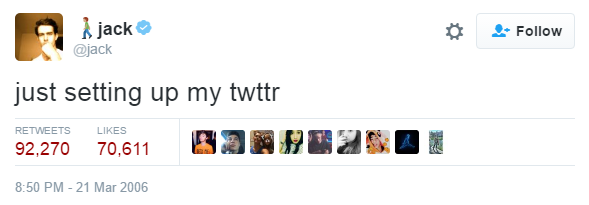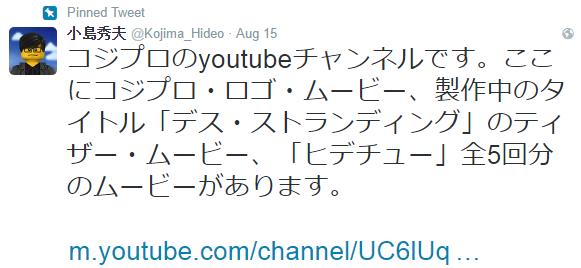Tweeting in Other Languages: Advantages and Disadvantages
As first steps in things that have become monumental, this very first Tweet by web designer Jack Dorsey is lacking in anything profound.
Since that first Tweet back in 2006 Twitter has grown into an unbelievably useful and responsive social media platform, where people can type before their brains engage and bullies have brought new meaning to the word troll. There’s even been positive stuff: raising public awareness through hashtag campaigns, celebrity endorsement of all and sundry that they hold near and dear has made us love these things too - or loath them, depending on what kind of follower you are. The possibilities, it would seem, are endless.
Different strokes for different folks…
Whether you use your Twitter account for micro-blogging, brain farts, or all manner of other things, the rules are the same for us all, verified or not. Tweets can use up to a maximum of 140 characters which includes spaces and punctuation. And even though @names no longer take up a character for every, well, character when you reply to a tweet, 140 characters is still not a lot of waxing lyrical.
Or is it?
If we are thinking of Twitter in terms of the language in which it was first created - and by that we mean English, not the complexities of computer programming language behind it - then 140 really is not much to play with. One letter equals one character, and unless you are posting nothing but haikus all day long, you had better post your epic masterpiece elsewhere.
It's all Greek Latin to me…
Because of course, as all speakers using a Latin alphabet want to do, we think of our own precious language first, sort of like the human equivalent of if it fits I sits…
The full list of languages that you can currently use Twitter in is:
Latin Alphabet: Afrikaans, Albanian, Basque, Bulgarian, Catalan, Croatian, Czech, Danish, Dutch, English, Esperanto, Filipino, Finnish, French, Galician, German, Greek, Hungarian, Indonesian, Italian, Irish, Latin, Latvian, Malay, Norwegian, Polish, Portuguese (Brazil), Romanian, Slovak, Spanish, Swedish, Turkish, Welsh, Vietnamese, Yoruba.
Non-Latin alphabets: Arabic, Belarusian, Bengali, Farsi/Persian, Gujarati, Hebrew, Hindi, Japanese, Kannada, Korean, Russian, Serbian, Simplified Chinese,Tamil, Thai, Traditional Chinese, Ukrainian, Urdu.
Somewhere in between/both: Kurdish, Marathi.
Let’s break down those ‘non-Latin’ alphabets further into two groups:
One character equals one letter/abugida/consonant: Arabic, Belarusian, Bengali, Farsi/Persian, Gujarati, Hebrew, Hindi, Kannada, Korean, Russian, Serbian, Tamil, Thai, Ukrainian, Urdu.
Logographic: Japanese, Chinese (modern and traditional).
Learning a new language? Check out our free placement test to see how your level measures up!
Everyone’s favourite…
GIF via Giphy
In 2013 during a broadcast of Hayao Miyazaki's Castle in the Sky, Japan all but broke the internet: the site recorded a peak of 143,199 Tweets per second. Twitter launched in Japan in 2008 and these technical-minded folk embraced it with the same love and affection they show for Pokémon and Hello Kitty. Twitter is considered Japan’s favourite social media platform, and possibly for the simple reason that 140 characters of Japanese can say so much more. Take this simple example:
This equates to around 90 characters:
And a rough Google Translation comes in at 163 characters:
There are other reasons for Twitter’s Japanese success of course, and one that is popularly cited is the fact that unlike in some countries, in Japan it is considered incredibly rude to talk on your phone whilst on the subway. Tweeting is a great get-around for that, and when you combine that with the relative privacy of Twitter compared with things like Facebook, you can see why it is so very loved by much of Japan.
No sloppy seconds…
China is known, unfairly, as the knock-off nation, where you can get a faux-everything for every occasion. This is also true for social media: China’s Twitter - although you must never call it that because they get very upset indeed - is Weibo.
Social micro-blogging site: check.
Memes: check - currently Leonardo DiCaprio is a favourite for that.
It sounds very much like Twitter to us, however, moving along...
Twitter itself in China is somewhat successful. It is estimated that there are around ten million users of Twitter in China, which, compared with the 65 million Twitter users in the US, that doesn’t sound like very much at all. But when you consider that Twitter has been blocked in China since 2009, and that these users are facilitating VPN workarounds just to access Twitter, that figure is actually quite impressive.
Weibo has begun to allow certain users to write longer messages, perhaps paving the way for Twitter to do the same, at which point this discussion could become obsolete. However, despite text-speak no longer being necessary, we continue to use it. Perhaps the habit of the 140-character tweet will be a hard one to break.
#TweetFromTheSeat...
We leave you with this most surprisingly successful hashtag campaign which proves that with advertising, less is more, and is perhaps why Twitter is such a popular platform. This marketing strategy from Charmin was apparently aimed at the 18-24 year old market because they are most likely to Tweet from the toilet…








